Muhammad Usman
University of Texas at Austin, USA
Multilingual Hate Speech Detection in Social Media Using Translation-Based Approaches with Large Language Models
Jun 09, 2025



Abstract:Social media platforms are critical spaces for public discourse, shaping opinions and community dynamics, yet their widespread use has amplified harmful content, particularly hate speech, threatening online safety and inclusivity. While hate speech detection has been extensively studied in languages like English and Spanish, Urdu remains underexplored, especially using translation-based approaches. To address this gap, we introduce a trilingual dataset of 10,193 tweets in English (3,834 samples), Urdu (3,197 samples), and Spanish (3,162 samples), collected via keyword filtering, with a balanced distribution of 4,849 Hateful and 5,344 Not-Hateful labels. Our methodology leverages attention layers as a precursor to transformer-based models and large language models (LLMs), enhancing feature extraction for multilingual hate speech detection. For non-transformer models, we use TF-IDF for feature extraction. The dataset is benchmarked using state-of-the-art models, including GPT-3.5 Turbo and Qwen 2.5 72B, alongside traditional machine learning models like SVM and other transformers (e.g., BERT, RoBERTa). Three annotators, following rigorous guidelines, ensured high dataset quality, achieving a Fleiss' Kappa of 0.821. Our approach, integrating attention layers with GPT-3.5 Turbo and Qwen 2.5 72B, achieves strong performance, with macro F1 scores of 0.87 for English (GPT-3.5 Turbo), 0.85 for Spanish (GPT-3.5 Turbo), 0.81 for Urdu (Qwen 2.5 72B), and 0.88 for the joint multilingual model (Qwen 2.5 72B). These results reflect improvements of 8.75% in English (over SVM baseline 0.80), 8.97% in Spanish (over SVM baseline 0.78), 5.19% in Urdu (over SVM baseline 0.77), and 7.32% in the joint multilingual model (over SVM baseline 0.82). Our framework offers a robust solution for multilingual hate speech detection, fostering safer digital communities worldwide.
InspectionV3: Enhancing Tobacco Quality Assessment with Deep Convolutional Neural Networks for Automated Workshop Management
May 22, 2025Abstract:The problems that tobacco workshops encounter include poor curing, inconsistencies in supplies, irregular scheduling, and a lack of oversight, all of which drive up expenses and worse quality. Large quantities make manual examination costly, sluggish, and unreliable. Deep convolutional neural networks have recently made strides in capabilities that transcend those of conventional methods. To effectively enhance them, nevertheless, extensive customization is needed to account for subtle variations in tobacco grade. This study introduces InspectionV3, an integrated solution for automated flue-cured tobacco grading that makes use of a customized deep convolutional neural network architecture. A scope that covers color, maturity, and curing subtleties is established via a labelled dataset consisting of 21,113 images spanning 20 quality classes. Expert annotators performed preprocessing on the tobacco leaf images, including cleaning, labelling, and augmentation. Multi-layer CNN factors use batch normalization to describe domain properties like as permeability and moisture spots, and so account for the subtleties of the workshop. Its expertise lies in converting visual patterns into useful information for enhancing workflow. Fast notifications are made possible by real-time, on-the-spot grading that matches human expertise. Images-powered analytics dashboards facilitate the tracking of yield projections, inventories, bottlenecks, and the optimization of data-driven choices. More labelled images are assimilated after further retraining, improving representational capacities and enabling adaptations for seasonal variability. Metrics demonstrate 97% accuracy, 95% precision and recall, 96% F1-score and AUC, 95% specificity; validating real-world viability.
Millimeter-Wave ISAC Testbed Using Programmable Digital Coding Dynamic Metasurface Antenna: Practical Design and Implementation
Feb 19, 2025Abstract:Dynamic Metasurface Antennas (DMAs) are transforming reconfigurable antenna technology by enabling energy-efficient, cost-effective beamforming through programmable meta-elements, eliminating the need for traditional phase shifters and delay lines. This breakthrough technology is emerging to revolutionize beamforming for next-generation wireless communication and sensing networks. In this paper, we present the design and real-world implementation of a DMA-assisted wireless communication platform operating in the license-free 60 GHz millimeter-wave (mmWave) band. Our system employs high-speed binary-coded sequences generated via a field-programmable gate array (FPGA), enabling real-time beam steering for spatial multiplexing and independent data transmission. A proof-of-concept experiment successfully demonstrates high-definition quadrature phase-shift keying (QPSK) modulated video transmission at 62 GHz. Furthermore, leveraging the DMA's multi-beam capability, we simultaneously transmit video to two spatially separated receivers, achieving accurate demodulation. We envision the proposed mmWave testbed as a platform for enabling the seamless integration of sensing and communication by allowing video transmission to be replaced with sensing data or utilizing an auxiliary wireless channel to transmit sensing information to multiple receivers. This synergy paves the way for advancing integrated sensing and communication (ISAC) in beyond-5G and 6G networks. Additionally, our testbed demonstrates potential for real-world use cases, including mmWave backhaul links and massive multiple-input multiple-output (MIMO) mmWave base stations.
Cardiverse: Harnessing LLMs for Novel Card Game Prototyping
Feb 10, 2025Abstract:The prototyping of computer games, particularly card games, requires extensive human effort in creative ideation and gameplay evaluation. Recent advances in Large Language Models (LLMs) offer opportunities to automate and streamline these processes. However, it remains challenging for LLMs to design novel game mechanics beyond existing databases, generate consistent gameplay environments, and develop scalable gameplay AI for large-scale evaluations. This paper addresses these challenges by introducing a comprehensive automated card game prototyping framework. The approach highlights a graph-based indexing method for generating novel game designs, an LLM-driven system for consistent game code generation validated by gameplay records, and a gameplay AI constructing method that uses an ensemble of LLM-generated action-value functions optimized through self-play. These contributions aim to accelerate card game prototyping, reduce human labor, and lower barriers to entry for game developers.
USEFUSE: Utile Stride for Enhanced Performance in Fused Layer Architecture of Deep Neural Networks
Dec 18, 2024



Abstract:Convolutional Neural Networks (CNNs) are crucial in various applications, but their deployment on resource-constrained edge devices poses challenges. This study presents the Sum-of-Products (SOP) units for convolution, which utilize low-latency left-to-right bit-serial arithmetic to minimize response time and enhance overall performance. The study proposes a methodology for fusing multiple convolution layers to reduce off-chip memory communication and increase overall performance. An effective mechanism detects and skips inefficient convolutions after ReLU layers, minimizing power consumption without compromising accuracy. Furthermore, efficient tile movement guarantees uniform access to the fusion pyramid. An analysis demonstrates the utile stride strategy improves operational intensity. Two designs cater to varied demands: one focuses on minimal response time for mission-critical applications, and another focuses on resource-constrained devices with comparable latency. This approach notably reduced redundant computations, improving the efficiency of CNN deployment on edge devices.
Biological Brain Age Estimation using Sex-Aware Adversarial Variational Autoencoder with Multimodal Neuroimages
Dec 07, 2024Abstract:Brain aging involves structural and functional changes and therefore serves as a key biomarker for brain health. Combining structural magnetic resonance imaging (sMRI) and functional magnetic resonance imaging (fMRI) has the potential to improve brain age estimation by leveraging complementary data. However, fMRI data, being noisier than sMRI, complicates multimodal fusion. Traditional fusion methods often introduce more noise than useful information, which can reduce accuracy compared to using sMRI alone. In this paper, we propose a novel multimodal framework for biological brain age estimation, utilizing a sex-aware adversarial variational autoencoder (SA-AVAE). Our framework integrates adversarial and variational learning to effectively disentangle the latent features from both modalities. Specifically, we decompose the latent space into modality-specific codes and shared codes to represent complementary and common information across modalities, respectively. To enhance the disentanglement, we introduce cross-reconstruction and shared-distinct distance ratio loss as regularization terms. Importantly, we incorporate sex information into the learned latent code, enabling the model to capture sex-specific aging patterns for brain age estimation via an integrated regressor module. We evaluate our model using the publicly available OpenBHB dataset, a comprehensive multi-site dataset for brain age estimation. The results from ablation studies and comparisons with state-of-the-art methods demonstrate that our framework outperforms existing approaches and shows significant robustness across various age groups, highlighting its potential for real-time clinical applications in the early detection of neurodegenerative diseases.
Multi-Task Adversarial Variational Autoencoder for Estimating Biological Brain Age with Multimodal Neuroimaging
Nov 15, 2024



Abstract:Despite advances in deep learning for estimating brain age from structural MRI data, incorporating functional MRI data is challenging due to its complex structure and the noisy nature of functional connectivity measurements. To address this, we present the Multitask Adversarial Variational Autoencoder, a custom deep learning framework designed to improve brain age predictions through multimodal MRI data integration. This model separates latent variables into generic and unique codes, isolating shared and modality-specific features. By integrating multitask learning with sex classification as an additional task, the model captures sex-specific aging patterns. Evaluated on the OpenBHB dataset, a large multisite brain MRI collection, the model achieves a mean absolute error of 2.77 years, outperforming traditional methods. This success positions M-AVAE as a powerful tool for metaverse-based healthcare applications in brain age estimation.
Quantum Machine Learning for Semiconductor Fabrication: Modeling GaN HEMT Contact Process
Sep 17, 2024
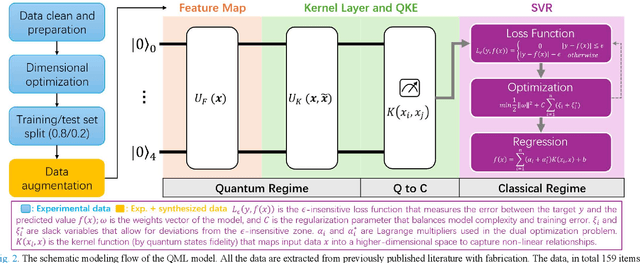
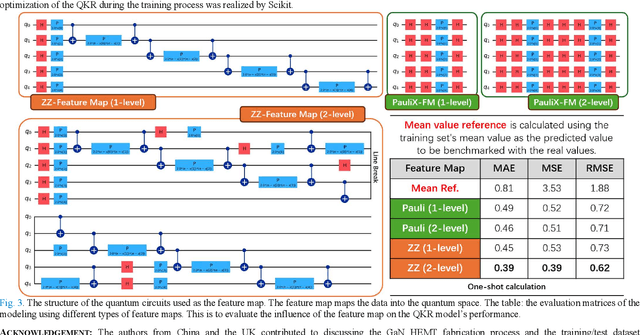
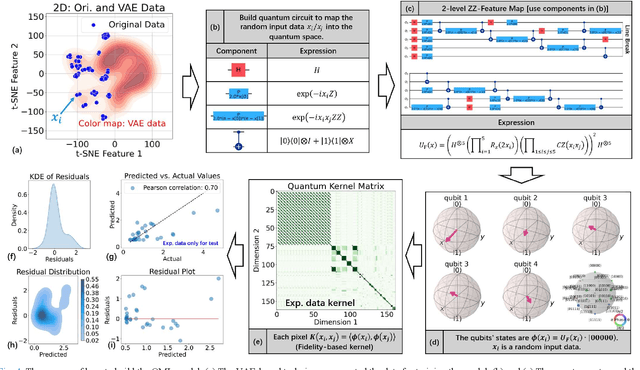
Abstract:This paper pioneers the use of quantum machine learning (QML) for modeling the Ohmic contact process in GaN high-electron-mobility transistors (HEMTs) for the first time. Utilizing data from 159 devices and variational auto-encoder-based augmentation, we developed a quantum kernel-based regressor (QKR) with a 2-level ZZ-feature map. Benchmarking against six classical machine learning (CML) models, our QKR consistently demonstrated the lowest mean absolute error (MAE), mean squared error (MSE), and root mean squared error (RMSE). Repeated statistical analysis confirmed its robustness. Additionally, experiments verified an MAE of 0.314 ohm-mm, underscoring the QKR's superior performance and potential for semiconductor applications, and demonstrating significant advancements over traditional CML methods.
Attention Down-Sampling Transformer, Relative Ranking and Self-Consistency for Blind Image Quality Assessment
Sep 11, 2024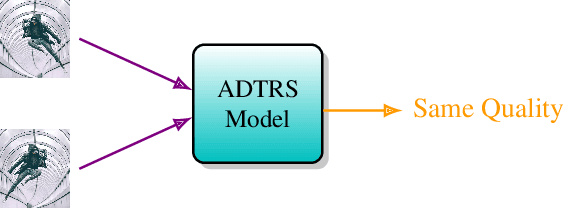
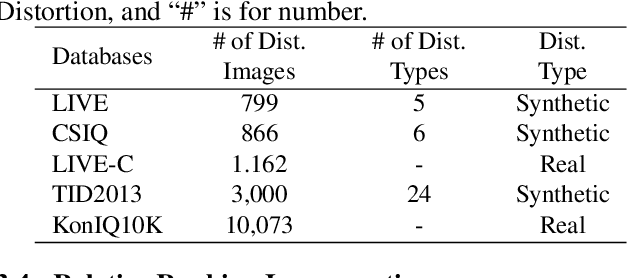
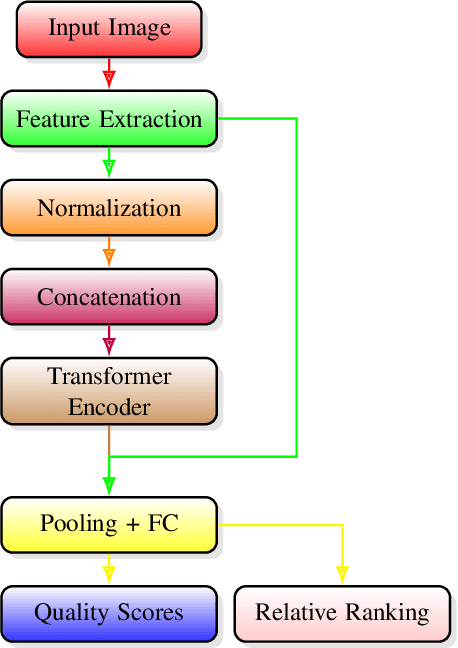
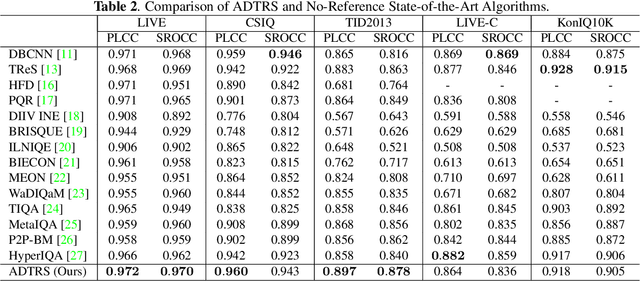
Abstract:The no-reference image quality assessment is a challenging domain that addresses estimating image quality without the original reference. We introduce an improved mechanism to extract local and non-local information from images via different transformer encoders and CNNs. The utilization of Transformer encoders aims to mitigate locality bias and generate a non-local representation by sequentially processing CNN features, which inherently capture local visual structures. Establishing a stronger connection between subjective and objective assessments is achieved through sorting within batches of images based on relative distance information. A self-consistency approach to self-supervision is presented, explicitly addressing the degradation of no-reference image quality assessment (NR-IQA) models under equivariant transformations. Our approach ensures model robustness by maintaining consistency between an image and its horizontally flipped equivalent. Through empirical evaluation of five popular image quality assessment datasets, the proposed model outperforms alternative algorithms in the context of no-reference image quality assessment datasets, especially on smaller datasets. Codes are available at \href{https://github.com/mas94/ADTRS}{https://github.com/mas94/ADTRS}
Quantum Kernel Principal Components Analysis for Compact Readout of Chemiresistive Sensor Arrays
Aug 28, 2024



Abstract:The rapid growth of Internet of Things (IoT) devices necessitates efficient data compression techniques to handle the vast amounts of data generated by these devices. In this context, chemiresistive sensor arrays (CSAs), a simple-to-fabricate but crucial component in IoT systems, generate large volumes of data due to their simultaneous multi-sensor operations. Classical principal component analysis (cPCA) methods, a common solution to the data compression challenge, face limitations in preserving critical information during dimensionality reduction. In this study, we present quantum principal component analysis (qPCA) as a superior alternative to enhance information retention. Our findings demonstrate that qPCA outperforms cPCA in various back-end machine-learning modeling tasks, particularly in low-dimensional scenarios when limited Quantum bits (qubits) can be accessed. These results underscore the potential of noisy intermediate-scale quantum (NISQ) computers, despite current qubit limitations, to revolutionize data processing in real-world IoT applications, particularly in enhancing the efficiency and reliability of CSA data compression and readout.
 Add to Chrome
Add to Chrome Add to Firefox
Add to Firefox Add to Edge
Add to Edge